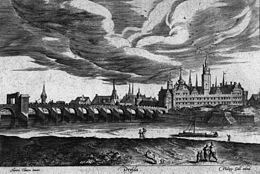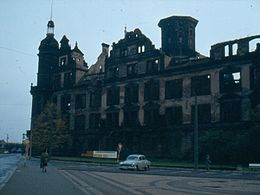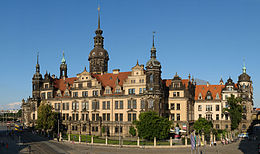- Dresden Castle
-
Residenzschloss Dresden 
General information Architectural style Neo-renaissance, Baroque Location Dresden,  Germany
GermanyConstruction started 1533–1535 (Georges Gate)
1565–1567 (Chancellery)
1586–1591 (Court's stall)
1589–1594 (Castle's yard)
1705–1708 (Taschenbergpalais)
1945 (Protection)
1991 [Start of WW2 reconstruction] (Tower)
2004 (Museum)
2013 (Reconstructed)Completed 1899 Design and construction Owner Free State of Saxony Other designers George, Duke of Saxony
Maurice, Elector of Saxony
Augustus, Elector of Saxony
Paul Buchner
Augustus II the StrongDresden Castle (German: Dresdner Residenzschloss or Dresdner Schloss) is one of the oldest buildings in Dresden. For almost 400 years, it has been the residence of the electors (1547–1806) and kings (1806–1918) of Saxony. It is known for the different architectural styles employed, from Baroque to Neo-renaissance.
Today, the residential castle is a museum complex that contains the Historic and New Green Vault, the Coin Cabinet, the Collection of Prints, Drawings and Photographs and the Turkish Chamber. It also houses an art library and the management of the Dresden State Art Collections.
Contents
History
The original castle was a Romanesque keep, built around 1200. The Hausmannsturm was built at the beginning of the 15th century. From 1468 until 1480, the keep was extended by the master builder, Arnold von Westfalen, becoming an enclosed four-wing construction. In the middle of the 16th century, an addition was added in the Renaissance style.
After a major fire in 1701, Augustus II the Strong rebuilt much of the castle in the Baroque style.[1] The collection rooms were created at this time in the western wing. The Silver Room, Heraldic Room and the Pretiosensaal were built from 1723–1726 and the Kaminzimmer, Juwelenzimmer (Jewel Room), Ivory Room and Bronze Room were built from 1727–1729.[1]
The 800th anniversary of the House of Wettin resulted in more rebuilding between 1889 and 1901. A Neo-renaissance renovation was undertaken, followed by various modernizations, such as in-floor heating and electric lights in 1914.[1]
Most of the castle was reduced to a roofless shell during the February 13, 1945 bombing of Dresden in World War II. The Heraldic, Jewel, Silver and Bronze Rooms were all destroyed. However, the collections survived, having been moved to safety at Königstein Fortress in the early years of the war.[1]
For the first 15 years after the end of the Second World War, no attempt was made to rebuild the castle, except to install a temporary roof in 1946. Restoration began in the 1960s with the installation of new windows and has occurred rapidly since then. The castle's restoration is due to be completed in 2013.[2][3]
Museums
Dresden castle houses five museums, the Historic Green Vault and the New Green Vault, the Coin Cabinet, the Collection of Prints, Drawings and Photographs and the Turkish Chamber.
Also accessible is an art library (Kunstbibliothek) with approximately 260,000 volumes of special literature on art history.[3] The character of the holdings is closely related to the collecting focal points of the museums.
The Gallery of the Electors and the Hausmannsturm, once Dresden's largest tower, can be visited as well.
Historic and New Green Vault
The Green Vault (Grünes Gewölbe) is a museum that contains the largest collection of treasures in Europe. Founded by Augustus II the Strong in 1723, it features a unique and rich variety of exhibits from the period of baroque to classicism. The museum consists of the Historic Green Vault (Historisches Grünes Gewölbe) and the New Green Vault (Neues Grünes Gewölbe).[4]
The Historic Green Vault is known for its treasure chambers, and is itself a baroque work of art. The New Green Vault is more modern. The Historic Green Vault is located on the ground floor of the Dresden Castle and visits require an advance booking; admittance to the New Green Vault, which is on the second floor, is not limited.
Coin Cabinet
The Coin Cabinet (Münzkabinett), with its nearly 300,000 pieces, is one of Dresden’s oldest museums, going back to the early 16th century. It contains one of the largest universal collections in Europe. Its broad spectrum ranges from classical antiquity to present-day coins. Some 30,000 Saxon coins and medals represent different periods in Saxony's history. The collection also includes orders and insignia, bank notes and historic bonds, models, seals, minting dies for coins and medals, as well as minting machines and equipment.[5] The Coin Cabinet is a center of scholarly research and has a library, open to the public, containing approximately 30,000 volumes.
Collection of Prints, Drawings and Photographs
The Collection of Prints, Drawings and Photographs (Kupferstich-Kabinett) shows work by renowned artists from numerous countries. There are approximately 515,000 objects by more than 20,000 artists across eight centuries. It holds drawings and prints by old masters such as Albrecht Dürer, Rembrandt, Michelangelo and Caspar David Friedrich, as well as later artists, like Henri de Toulouse-Lautrec and Pablo Picasso. Engravings by Martin Schongauer and woodcuts by Lucas Cranach the Elder are shown along with photographic works.[6] There is also a collection of drawings and graphic art by Käthe Kollwitz.
Turkish Chamber
The Turkish Chamber (Türckische Cammer), opened in 2010, displays more than 600 objects of art from the Ottoman Empire, making it one of the oldest and most significant collections outside Turkey. Between the 16th and the 19th centuries, the electors of Saxony, motivated by their passion for collecting and their desire for princely prestige, amassed a wealth of "turquerie".
The largest object in the Turkish Chamber is a three-mast tent, 20 m (66 ft) long, 8 m (26 ft) wide and 6 m (20 ft) high, made of gold and silk. In addition, there are eight life-sized, carved wooden horses and a group of reflex bows with original strings, the oldest of which dates from 1586.[7] Also shown are weapons, suits of chain mail, helmets, flags and costumes.
See also
- Pillnitz Castle – Summer residence of the electors and kings of Saxony
- Moritzburg Castle – Hunting lodge of the electors and kings of Saxony
- List of castles in Saxony
Notes and references
- ^ a b c d Fritz Löffler: Das alte Dresden - Geschichte seiner Bauten. 16th ed. Leipzig: Seemann, 2006, ISBN 9783865020000 (German)
- ^ "Dresden Residential Castle". Schlösserland Sachsen. 2011. http://www.schloesserland-sachsen.de/en/palaces_castles_and_gardens/palaces/dresden_residential_castle/. Retrieved 13 October 2011.
- ^ a b "Residenzschloss (Royal Palace)". Dresden State Art Collections. 2011. http://www.skd.museum/en/museums-institutions/residenzschloss/index.html. Retrieved 13 October 2011.
- ^ "Grünes Gewölbe (Green Vault)". Dresden State Art Collections. 2011. http://www.skd.museum/en/museums-institutions/residenzschloss/gruenes-gewoelbe/index.html. Retrieved 31 October 2011.
- ^ "Münzkabinett (Coin Cabinet)". Dresden State Art Collections. 2011. http://www.skd.museum/en/museums-institutions/residenzschloss/muenzkabinett/index.html. Retrieved 31 October 2011.
- ^ "Kupferstich-Kabinett (Collection of Prints, Drawings and Photographs)". Dresden State Art Collections. 2011. http://www.skd.museum/en/museums-institutions/residenzschloss/kupferstich-kabinett/index.html. Retrieved 31 October 2011.
- ^ "The Türckische Cammer – a feast for the eyes". Dresden State Art Collections. 2011. http://www.skd.museum/en/museums-institutions/residenzschloss/ruestkammer/tuerckische-cammer/index.html. Retrieved 31 October 2011.
External links
 Media related to Residenzschloss Dresden at Wikimedia Commons
Media related to Residenzschloss Dresden at Wikimedia Commons- Dresden Residential Castle at Schlösserland Sachsen
- Residenzschloss at Staatliche Kunstsammlungen Dresden
Coordinates: 51°03′10″N 13°44′13″E / 51.05278°N 13.73694°ECategories:- Palaces in Dresden
- Royal residences in Saxony
- Art museums and galleries in Dresden
- Museums in Dresden
Wikimedia Foundation. 2010.



